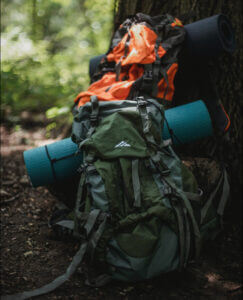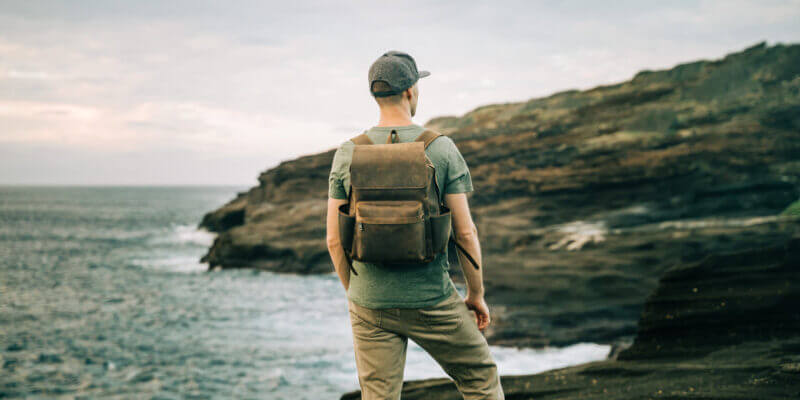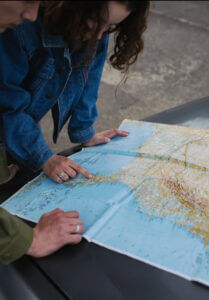The Most Important Parts of Your Bug Out Plans
One of the most popular forms of survival planning is the bug out plan. When most people think of bugging out, they believe it revolves solely around having a bag full of all the gear you need so that, in the event of an emergency, you can simply pick up and go from wherever you are.

Many people go to great lengths to research what the best products are to put into the bug out bag itself, but there’s much more to it than that. Supplies are critical, but they’re equally as important as knowing what you’re actually going to do once the emergency starts.
Below, you’ll get a better idea of what we well-rounded bug out strategy entails and what you need to consider in addition to the supplies. That way, you and your loved ones will have the peace of mind and capability it takes to weather any major survival event.
Make Sure You Pack the Best Supplies for Your Escape
Naturally, what you pack in your bag is going to make a big difference in how comfortably you’ll be able to survive immediately after a major emergency. You want to find a good balance of creature comforts as well as the items needed for your survival.
First, you’ll want to address the “big three” aspects of survival: food, water, and shelter. This can be accomplished fairly easily in a bug out bag. To start with, you should focus on water, since you can’t last nearly as long without it.
You should pack at least one form of water purification, whether it be iodine tablets or a filter straw. This will allow you to keep getting access to clean drinking water wherever you are, as long as you have the ability to find something like a river or a pond.
In addition, it’s worth having a large water bottle on hand that you can store that water in. You want to make sure it’s durable and can be roughly handled on your journey, so don’t go for something like a disposable water bottle.
Food is fairly easy to plan as well. Since your bug out bag will be sitting for awhile, you want to have some non-perishable foods in there, like MREs. These will keep for a long time and can supply you with plenty of nutrients.
For shelter, you should be able to strap a tent and sleeping bag to the outside of your bug out bag. These can be a bit bulky, but if they’re rolled up correctly, you shouldn’t run into any major issues.
Finally, pack items like first aid kits as well as things that can keep you occupied. It’s easy to get bogged down and stressed out after an emergency, and something simple like a small book or magazines can help you relax a bit.
Once you have the basics, you can start adding on to the supplies found in your bag, including anything that will fit and that you’ll have the strength to carry. If you’re putting one in your car, try to select items that will easily survive extreme heat and cold conditions so the supplies don’t ruin while being left in the vehicle.
Ensure That You Become Mentally Prepared for a Bug Out Survival Situation
One of the most commonly overlooked parts of survival is the mental aspect. In fact, some survivalist pros have noted that the most dangerous thing you can possibly do in any survival situation is panic.
If you’re mentally prepared to deal with the dangers and hardships associated with bugging out, you’ll be able to keep a level head and make better decisions. In certain situations, making the right decision can affect the outcome of your survival.
There are a few different things you can do to make yourself feel more comfortable in a survival situation. One of the most important things you can have ahead of time is experience.
If you can get experience using each part of your kit and putting it to use in a practical way, it will all feel more familiar to you and become second nature to you. Whether it be starting a fire with a fire starter or building your tent, you need to have practice.
Imagine that you’re in a bug out situation. You grabbed your bag, and headed out into nature away from the emergency. As night falls, you need to get a fire going and get your shelter ready, but this is your first time using your tools.
You might be using the fire starter wrong, unable to produce any sparks to get a fire going. Additionally, you might not know how the tent poles connect together, and are unable to sleep comfortably at all that night since you don’t have a proper shelter.
Situations like this can be avoided if you take the time sooner rather than later to learn about each item in your kit. Some groups even offer classes for survivalists, teaching you how to do anything you’ll need to know in a bug out situation.
However, a class is not necessary. You can get it through trial and error if you work at it, as long as you have the tools on hand. You can even use online resources like videos and step-by-step tutorials to ensure you’re doing things correctly.
Having experience working with your tools will give you much more confidence and make you much less likely to panic. You’ll also increase your chances of survival just by having that knowledge to begin with.
It’s also important to have something to keep you occupied while you’re out in the wilderness. You won’t have to be doing something at every waking moment, and you’ll quickly become bored, which might send your mind racing into a state of panic and worry.
By having things to keep yourself entertained, you can at least have some relaxation and down time – even without electricity. This can also help keep your kids from panicking, since too much down time without doing anything can make them feel stir crazy.
Have a Destination in Mind That You Can Reach
In the event of a bug out scenario, many people have the contents of their bags memorized and all, but you might not know where you even plan to go. Instead of heading in any random direction, plan in advance what place would be best.
This will vary from person to person and location to location, of course, but the ideal destination should be somewhere that you can reach on foot in a reasonable amount of time that can also supply things like food and water.
You’re going to generally want to find some place in the wilderness that you can go to, especially somewhere where you’ll be able to camp out and live somewhat comfortably out of a tent.
Try to avoid rocky or unstable areas, or those prone to flooding. While you might not want to set up camp on a river bank, you shouldn’t set up too far from a fresh water source.
Otherwise, you’ll be needing to go on long hikes to get yourself water, which you might need to do daily. Try going a few camping trips around your area in different places to figure out which area suits you best.
It doesn’t have to be an exact spot, but just a general area that you know will be livable. Once you’ve decided on a good spot, you ought to try to make semi-regular trips out there to camp and get a feel for the area.
The more familiar it is, the less alien it will feel when you’re there for survival. It will also be much easier for you to navigate the area. You won’t constantly have to check your compass to see which way you should go to get to the river, for example.
It also helps lower the chances of you getting lost. It’s also worth having a few different maps with that area marked, so that you and your loved ones know where to go. If you can find or make a local map of your secluded area, that’s even better.
Having a common spot for your friends or family to meet you at is very helpful for a bug out scenario. Chances are you aren’t all going to be in the same place at the same time, so you’ll have to figure out how to meet up.
There’s no guarantee that there will be available phone lines or cell service in a major emergency, so you should try to find a way for them to have a map as well that they can use to meet up with you.
Another thing to consider about your destination is the different seasons. It might be fine when you visit in autumn, but in spring and summer, it might be crawling with too many insects, and in winter it may be too cold.
Staying Physically Fit Helps When Bugging Out
An often overlooked aspect of bug out survival is how physically difficult it is to accomplish. It’s not as simple as just driving out somewhere and camping out for a few days, and instead it’s a very demanding physical task.
First, there’s the matter of actually getting to your ideal bug out location. If you live near a major city, the best out of the way camping spot might be many miles away. Just the act of walking that distance would be very demanding for most people.
Since many adults are sedentary today, they lack the necessary stamina and cardio to be able to walk long distances, especially a distance of 10 miles or more. Additionally, in a bug out situation, you would probably want to go at a faster pace than a walk.
The reason you have to be prepared to go on foot is that there’s no guarantee that you can use your car. The roads would be clogged, but certain scenarios may also prevent you from using your car, or you could be out of gas at the moment.
You have to be prepared to at least walk as far as your destination when you’re preparing for bug out survival. As you train for this, you might focus on walking on different terrain as well, since the roads won’t be as nice as a treadmill.
There’s also the matter of carrying all of your gear. When you have all of your food, water, shelter, and tools packed in a large backpack, it can be very heavy. Often times, the large packs that soldiers carry around are well over 50 pounds.
All of that added weight that you have to carry will make your long journey that much more difficult. It can put a serious strain on your body to carry such a large amount of extra weight for such a long distance.
For similar reasons, it would also be wise to get in as good of shape as you can. Losing weight and gaining muscle will make it much easier for you to take on the long trek ahead of you.
It’s also better for you to get accustomed to eating less food. This can help immensely for losing weight, but you’ll also be more used to eating the very small amounts that you’ll have to when you’re surviving in the wilderness.
Being physically fit is very important for outdoors survival for things like gathering resources. For example, you might have to climb up some trees or rocks to get to food, and will have to be strong to carry things like logs around for more permanent shelter.
By starting now, you can get ahead of the curve and be ready for any bug out scenario. There are many different ways to get in shape, but practicing long walks and runs are going to be crucial for preparation.
Have Multiple Backup Bug Out Plans
There’s no guarantee that the area you want to bug out to will be ideal for every single bug out situation. There are many different disasters that might cause you to pack up and run, and some of them might require different plans.
For example, in a natural disaster like a blizzard, you probably wouldn’t want to run out into the woods, because it will be freezing cold and full of snow. Instead, you’d want to try and follow some kind of evacuation procedure to somewhere warm or safe.
In some bug out scenarios, you might have access to your car, and be able to get away much further than you would on foot. This might also warrant a backup plan, since you’ll be dealing with a different destination.
You might also get to your first choice destination and find that it’s already occupied. Since you might not want to risk camping out so close to another group of individuals, you should have a location in mind that you can fall back on.
It’s very important to have backup plans so that you don’t stress when something goes wrong. Instead of making a bad decision out of panic, you’ll be able to swap over to another plan quickly and efficiently.
You should also have backup plans for alternative methods of getting food, water, and shelter. There’s no guarantee that your food and water supplies will last, and premade shelters like tents can fail.
When it comes to food, you should be ready and knowledgeable when it comes to scavenging and even hunting. You can only pack so many MREs or canned foods into one backpack before it becomes too heavy, and they won’t last you too long.
While you can pack a decent supply of water in the form of a few bottles, that too will run out quickly. You’re going to need plenty of water for things like cleaning yourself and cooking as well as normal drinking water, and you need a way of getting clean water.
Any kind of transportable filter or purification tablets should help you with this, as well as a large water bottle for transporting it. This is essential for any good bug out bag, as it’s likely that the emergency you’re in will outlast your water supply.
While there’s not much you can pack to be prepared for the failure of your shelter, you can be knowledgeable with woodworking and bush craft, which can enable you to build your own shelter using the supplies you have access to in the wild.
Be sure to have all the tools you might need to assemble a shelter out of supplies you find in the wild. This might require things like a hatchet, para-cord, and other common survivalist supplies.
Just remember that a big out plan is more than just “supplies that go in a backpack.”
It’s an entire strategy based around getting out of a dangerous situation and having the mental and physical ability to handle harsh conditions that will test your ability to survive.






